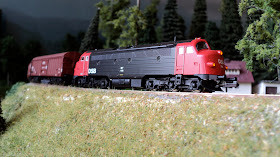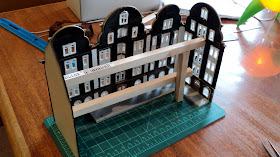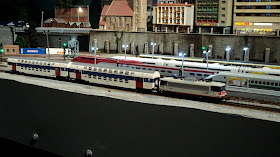An addition from Denmark joins the fleet, courtesy of a Japanese manufacturer of an American based locomotive built in Sweden and purchased by me from a dealer in Germany. How's that for globalism?
A couple of things I should mention that I didn't cover or realize when I created the above video review. First, while the locomotive is commonly referred to as a "NOHAB", that is actually the name of the Swedish firm Nydqvist och Holm AB that licensed the GM F-series technology (nice site on this interesting topic here). Well, if the locomotive is not called a "NOHAB", what is it called? I believe the proper (though never used) designation is AA16. I'm pretty sure that if I called this an "AA16" no one would know what I am referring to, but I think that's a pretty interesting bit of trivia.
Another interesting 'error' regarding the "NOHAB", is that the Swedish firm only made this unit for Norway, Denmark, and Hungary. The similar version of this locomotive created for the SNCB in Belgium (and the CFL in Luxembourg) was actually created under a seperate license by manufacturer Anglo-Franco-Belge (AFB). So these are not, technically, "NOHABs".
A bit off topic, is that getting a clear understanding of the SNCB "NOHAB" type locomotives is a bit confusing. They were originally given the class numbers of 202 and 203 and later Class 53 and 52. But I found investigating these classes in the Belgian fleet fairly confusing as many of the images or locomotives in these classes do not share the distinctive 'bulldog' or F-series faces, but rather the angular (which is sadly, not represented in N Scale) style that is distinctive of a lot of the older Belgian diesels. It does look like it might just be the faces that are different, but I don't know for sure.
The prototype is interesting as well. These locomotives are thought of highly with European rail fans, and seem to have similar respect from rail fans as the US F-series locomotives are in the states. However, many of these locomotives appear to still be in revenue operation, although most of that is from 'second-hand' purchases from Kosovo and other countries.
Back to the Kato model. Its everything you would expect from Kato. Smooth running, good details and castings, sharp printing and paint. Very solid. Easily converted to DCC with an NEM 651 plug.
One warning however, is that the buffers are in fairly loosely and I've already lost one (something else I failed to mention in the video).
My only 'problem' with it is the black seemed so shiny that I had to do something I've rarely done before and applied a bit of weathering and some matte spray paint. Below is a photo of the locomotive 'before....
And then 'after':
For my tastes, its a big improvement (although now the bogies are a bit too shiny! LOL! Something to work on at a later point!)! I'm a big fan of black locomotives, and the sharp black and red colors of this DSB scheme look very industrial and bold!






























